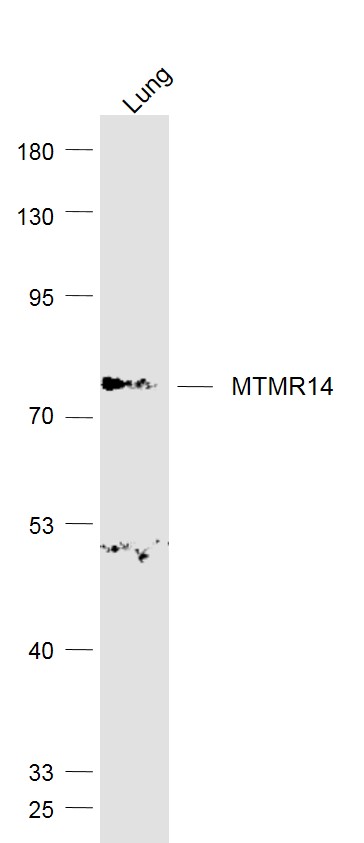
Rabbit Anti-MTMR14 antibody
C3orf29; Egg derived tyrosine phosphatase homolog; FLJ11546; FLJ22405; FLJ46453; FLJ90311; HCV NS5A transactivated protein 4 splice variant A binding protein 1; HCV NS5A-transactivated protein 4 splice variant A-binding protein 1; hJumpy; jumpy; MTMR 14;
View History [Clear]
Details
Product Name MTMR14 Chinese Name 肌管素相关蛋白14抗体 Alias C3orf29; Egg derived tyrosine phosphatase homolog; FLJ11546; FLJ22405; FLJ46453; FLJ90311; HCV NS5A transactivated protein 4 splice variant A binding protein 1; HCV NS5A-transactivated protein 4 splice variant A-binding protein 1; hJumpy; jumpy; MTMR 14; MTMR14; MTMR-14; MTMRE_HUMAN; Myotubularin related protein 14; Myotubularin-related protein 14; NS5ATP4ABP1. Research Area Cell biology immunology Kinases and Phosphatases Immunogen Species Rabbit Clonality Polyclonal React Species Mouse, (predicted: Human, Rat, Chicken, Dog, Pig, Cow, Horse, Rabbit, Sheep, ) Applications WB=1:500-2000 ELISA=1:5000-10000 IHC-P=1:100-500 IHC-F=1:100-500 ICC=1:100-500 IF=1:100-500 (Paraffin sections need antigen repair)
not yet tested in other applications.
optimal dilutions/concentrations should be determined by the end user.Theoretical molecular weight 72kDa Cellular localization cytoplasmic The cell membrane Form Liquid Concentration 1mg/ml immunogen KLH conjugated synthetic peptide derived from human MTMR14: 161-260/650 Lsotype IgG Purification affinity purified by Protein A Buffer Solution 0.01M TBS(pH7.4) with 1% BSA, 0.03% Proclin300 and 50% Glycerol. Storage Shipped at 4℃. Store at -20 °C for one year. Avoid repeated freeze/thaw cycles. Attention This product as supplied is intended for research use only, not for use in human, therapeutic or diagnostic applications. PubMed PubMed Product Detail Myotubularin-related protein 14 (MTMR14), also known as Jumpy, is a myotubularin-related phosphoinositol-3-phosphate (PI3P) phosphatase (1). Mutations in the MTMR14 gene have been associated with centronuclear myopathy (1). MTMR14 deficiency in mice leads to altered calcium homeostasis and muscle disorders (2). MTMR14 has also been shown to play a role in autophagy, a process that is highly regulated by phosphatidylinositides through the type III PI3K, Vps34 (3). MTMR14 was localized to autophagic isolation membranes and early autophagosomes (3). In these studies, MTMR14 inhibited autophagy and mutations of MTMR14 associated with centronuclear myopathy were also defective in autophagy inhibition. In zebrafish, MTMR14 knockdown was shown to increase the number of autophagosomes, suggesting that its activity is associated with an inhibition of autophagy (4).
Function:
Lipid phosphatase which efficiently dephosphorylates phosphatidylinositol 3-phosphate (PtdIns3P) and PtdIns(3,5)P2; inactive toward PtdIns4P, PtdIns(3,4)P2, PtdIns(4,5)P2 and PtdIns(3,4,5)P3.
Subunit:
Belongs to the protein-tyrosine phosphatase family. Non-receptor class myotubularin subfamily.
Subcellular Location:
Cytoplasm. Found in reticular structures and plasma membrane ruffles. Concentrated near the nucleus.
Tissue Specificity:
Expressed in various tissues, including heart, skeletal muscle, placenta, liver, lung, kidney and pancreas.
DISEASE:
Defects in MTMR14 may be a cause of centronuclear myopathy autosomal dominant (ADCNM) [MIM:160150]; also known as autosomal dominant myotubular myopathy. Centronuclear myopathies are congenital muscle disorders characterized by progressive muscular weakness and wasting involving mainly limb girdle, trunk, and neck muscles. It may also affect distal muscles. Weakness may be present during childhood or adolescence or may not become evident until the third decade of life. Ptosis is a frequent clinical feature. The most prominent histopathologic features include high frequency of centrally located nuclei in muscle fibers not secondary to regeneration, radial arrangement of sarcoplasmic strands around the central nuclei, and predominance and hypotrophy of type 1 fibers.
Similarity:
Belongs to the protein-tyrosine phosphatase family. Non-receptor class myotubularin subfamily.
SWISS:
Q8NCE2
Gene ID:
64419
Database links:Entrez Gene: 64419 Human
Entrez Gene: 97287 Mouse
Omim: 611089 Human
SwissProt: Q8NCE2 Human
SwissProt: Q8VEL2 Mouse
Unigene: 475382 Human
Unigene: 197816 Mouse
Product Picture
Bought notes(bought amounts latest0)
No one bought this product
User Comment(Total0User Comment Num)
- No comment



 +86 571 56623320
+86 571 56623320
 +86 18668110335
+86 18668110335

